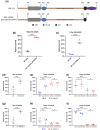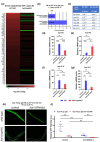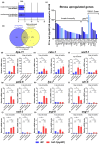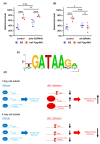Age-dependent heat shock hormesis to HSF-1 deficiency suggests a compensatory mechanism mediated by the unfolded protein response and innate immunity in young Caenorhabditis elegans
- PMID: 38895933
- PMCID: PMC11464127
- DOI: 10.1111/acel.14246
Age-dependent heat shock hormesis to HSF-1 deficiency suggests a compensatory mechanism mediated by the unfolded protein response and innate immunity in young Caenorhabditis elegans
Abstract
The transcription factor HSF-1 (heat shock factor 1) acts as a master regulator of heat shock response in eukaryotic cells to maintain cellular proteostasis. The protein has a protective role in preventing cells from undergoing ageing, and neurodegeneration, and also mediates tumorigenesis. Thus, modulating HSF-1 activity in humans has a promising therapeutic potential for treating these pathologies. Loss of HSF-1 function is usually associated with impaired stress tolerance. Contrary to this conventional knowledge, we show here that inactivation of HSF-1 in the nematode Caenorhabditis elegans results in increased thermotolerance at young adult stages, whereas HSF-1 deficiency in animals passing early adult stages indeed leads to decreased thermotolerance, as compared to wild-type. Furthermore, a gene expression analysis supports that in young adults, distinct cellular stress response and immunity-related signaling pathways become induced upon HSF-1 deficiency. We also demonstrate that increased tolerance to proteotoxic stress in HSF-1-depleted young worms requires the activity of the unfolded protein response of the endoplasmic reticulum and the SKN-1/Nrf2-mediated oxidative stress response pathway, as well as an innate immunity-related pathway, suggesting a mutual compensatory interaction between HSF-1 and these conserved stress response systems. A similar compensatory molecular network is likely to also operate in higher animal taxa, raising the possibility of an unexpected outcome when HSF-1 activity is manipulated in humans.
Keywords: C. Elegans; skn‐1; autophagy; cellular stress response; heat shock factor 1; heat shock proteins; heat shock response; hormesis; innate immunity; insulin‐like signaling pathway; intracellular pathogen response; proteostasis; thermotolerance; unfolded protein response.
© 2024 The Author(s). Aging Cell published by Anatomical Society and John Wiley & Sons Ltd.
Conflict of interest statement
The authors declare no competing financial interest.
Figures






Similar articles
-
Hormetic heat shock and HSF-1 overexpression improve C. elegans survival and proteostasis by inducing autophagy.Autophagy. 2017 Jun 3;13(6):1076-1077. doi: 10.1080/15548627.2017.1299313. Epub 2017 Mar 23. Autophagy. 2017. PMID: 28333578 Free PMC article.
-
Hormetic heat stress and HSF-1 induce autophagy to improve survival and proteostasis in C. elegans.Nat Commun. 2017 Feb 15;8:14337. doi: 10.1038/ncomms14337. Nat Commun. 2017. PMID: 28198373 Free PMC article.
-
Phytochemicals-induced hormesis protects Caenorhabditis elegans against α-synuclein protein aggregation and stress through modulating HSF-1 and SKN-1/Nrf2 signaling pathways.Biomed Pharmacother. 2018 Jun;102:812-822. doi: 10.1016/j.biopha.2018.03.128. Epub 2018 Apr 5. Biomed Pharmacother. 2018. PMID: 29605769
-
The Thermal Stress Coping Network of the Nematode Caenorhabditis elegans.Int J Mol Sci. 2022 Nov 28;23(23):14907. doi: 10.3390/ijms232314907. Int J Mol Sci. 2022. PMID: 36499234 Free PMC article. Review.
-
Heat shock and genetic activation of HSF-1 enhance immunity to bacteria.Cell Cycle. 2006 Nov 1;5(21):2443-6. doi: 10.4161/cc.5.21.3434. Epub 2006 Sep 25. Cell Cycle. 2006. PMID: 17106259 Review.
Cited by
-
Antiaging Effect of 2-O-β-D-Glucopyranosyl Ascorbic Acid Derived from Lycium barbarum L. Through Modulating the IIS Pathway and Gut Microbiota in Caenorhabditis elegans.Foods. 2025 May 25;14(11):1875. doi: 10.3390/foods14111875. Foods. 2025. PMID: 40509403 Free PMC article.
-
Transcriptomic and chromatin accessibility profiling unveils new regulators of heat hormesis in Caenorhabditis elegans.bioRxiv [Preprint]. 2025 Mar 14:2025.03.11.642714. doi: 10.1101/2025.03.11.642714. bioRxiv. 2025. PMID: 40161833 Free PMC article. Preprint.
-
The neurohormone tyramine stimulates the secretion of an insulin-like peptide from the Caenorhabditis elegans intestine to modulate the systemic stress response.PLoS Biol. 2025 Jan 28;23(1):e3002997. doi: 10.1371/journal.pbio.3002997. eCollection 2025 Jan. PLoS Biol. 2025. PMID: 39874242 Free PMC article.
References
-
- Afgan, E. , Baker, D. , Batut, B. , van den Beek, M. , Bouvier, D. , Cech, M. , Chilton, J. , Clements, D. , Coraor, N. , Grüning, B. A. , Guerler, A. , Hillman‐Jackson, J. , Hiltemann, S. , Jalili, V. , Rasche, H. , Soranzo, N. , Goecks, J. , Taylor, J. , Nekrutenko, A. , & Blankenberg, D. (2018). The galaxy platform for accessible, reproducible and collaborative biomedical analyses: 2018 update. Nucleic Acids Research, 46, W537–W544. - PMC - PubMed
-
- Aman, Y. , Schmauck‐Medina, T. , Hansen, M. , Morimoto, R. I. , Simon, A. K. , Bjedov, I. , Palikaras, K. , Simonsen, A. , Johansen, T. , Tavernarakis, N. , Rubinsztein, D. C. , Partridge, L. , Kroemer, G. , Labbadia, J. , & Fang, E. F. (2021). Autophagy in healthy aging and disease. Nature Aging, 1, 634–650. - PMC - PubMed
MeSH terms
Substances
Grants and funding
- ÚNKP-23-3/New National Excellence Program of the Ministry for Culture and Innovation
- 01062/Eötvös Loránd Research Network
- P40 OD010440/OD/NIH HHS/United States
- DKOP-23/New National Excellence Program of the Ministry for Culture and Innovation
- K132439/National Research, Development and Innovation Office
LinkOut - more resources
Full Text Sources
Molecular Biology Databases

